 Charming. I'd like to use that word to describe Buenos Aires. The old buildings, the boulevards, the open spaces and Tango. They are all charming.
Charming. I'd like to use that word to describe Buenos Aires. The old buildings, the boulevards, the open spaces and Tango. They are all charming.Follow this Filipino guy as he takes you around the "Paris of the South" through his pictures and his travelogues.
I was working from home when I got my Buenos Aires postcard in the mail and it was a coincidence that I had been listening that day to the tango music CDs that we also bought from Buenos Aires.
It has only been a week and half since we got back from Argentina but listening to the Tango music made it feel like the trip just happened yesterday. Funny how music has that effect on me. Years from now, Tango music will take me back to this trip the way Flamenco, Bossa Nova, Gypsy Jazz and the other music CDs allow me to travel back in time to the places where I bought them.

One of the things I will remember about our trip to Buenos Aires was the weather. February is mid summer in Buenos Aires. I tend to romanticize summer a lot so the warm breeze added more romantic ingredients to pair with the buildings that have stood the test of time, the lovely parks and the wide avenues.
The sun was glaring down at us while it took us forever crossing 9 de Julio Avenue. It took us a long time to cross because the avenue happens to be the widest avenue in the world. Blue skies provided me a great background to capture the obelisk.
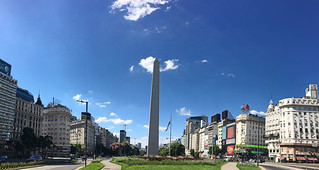
Just looking at the buidings, I can tell that Buenos Aires had a glorious past. It is like looking at a picture of a great artist who has passed away. This was another one of those moments where I was telling myself, "Imagine, this Filipino guy from a small town is in Buenos Aires crossing this wide avenue and seeing this obelisk?" I used to read about BA in my social studies books during my grammar school days and here I was taking pictures to take with me.
Another memorable scene was our walks along the streets of BA. Walking along Avenida de Mayo will truly give you a whiff of that old grandeur that BA had. Very old world. I can't imagine how this avenue used to look like in the early 1900s and how exciting and fashionable it must have been to stroll along this avenue.
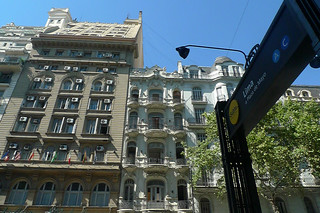
The trees complement the avenues and provide a natural look very much like the avenues in Paris. Mijo and I probably walked about ten to eleven blocks on Avenida de Mayo at one point without thinking about our itinerary of the day. We absolutely enjoyed strolling along not only talking about Buenos Aires but also about us in general and about the present and the future.

The trees complement the avenues and provide a natural look very much like the avenues in Paris. Mijo and I probably walked about ten to eleven blocks on Avenida de Mayo at one point without thinking about our itinerary of the day. We absolutely enjoyed strolling along not only talking about Buenos Aires but also about us in general and about the present and the future.
Plaza de Mayo marks the beginning of Avenida de Mayo. This is where you can find the Casa Rosada or the Government House. It is the office of the President of Argentina.
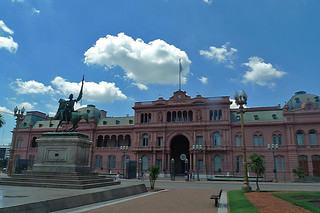
Here is a monument to General Manuel Belgrano. He was one of the country's leaders that took part in the country's liberation.
Buildings such as governments offices and the Catedral de Metropolitana are all near Avenida de Mayo. Mijo and I also talked about how Manila would probably look like this had it not been for the war.
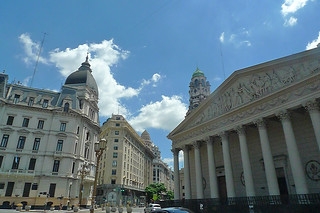
The Museo Histórico Nacional del Cabildo y la Revolución de Mayo is on the avenue as well. This museum is a good introduction to Buenos Aires' history and culture.
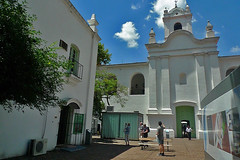
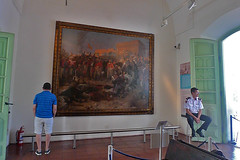
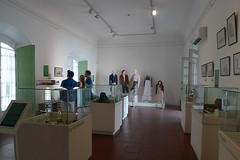
At the end of Avenida de Mayo, about ten blocks from the Plaza de Mayo, you'll find this huge neo classical building called Congreso de la Nación Argentina which is the Argentinean parliament building.

Also along Avenida de Mayo is this record store where Mijo and I bought our tango CDs. Great selection of old and modern tango music. Sorry. I forgot the name of this store.
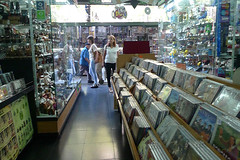
One of my most memorable experiences in BA. No other building exudes that grandeur Buenos Aires once had than
Teatro Colón.
The details on the outside are as lavish on the outside as they are on the inside. I am not really sure which one is the front or the back but I took pictures of both sides so to capture the elegance of the façade.
Teatro Colón.
The details on the outside are as lavish on the outside as they are on the inside. I am not really sure which one is the front or the back but I took pictures of both sides so to capture the elegance of the façade.
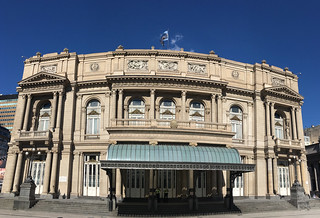
This is the second Teatro Colón. The first one opened in 1857 and was later replaced by the current one. The current Teatro started construction 1889 and finish in 1908. It was renovated and reopened in 2010.
We were fortunate to get a ticket for the tour inside the theatre. There are no performances during summer months of January and February so the tours are available for a fee all day long. We were also fortunate that we traveled to Buenos Aires when the theatre reopened after its remodelling.
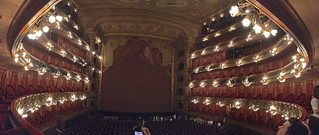
I learned that the Teatro has one of the best acoustics in the world. The tour also led us to the orchestra seats, the President's suite, and the middle suites.
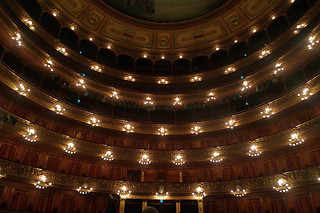
I also loved the interior design. I can't imagine the amout of work to refurbish the huge theatre. The other details such as stairs, hallways, ceilings, floor tilework, sculptures are so impressive as well. The theatre also has an area, sort of like a museum, where the old costumes used in popular productions are on display.
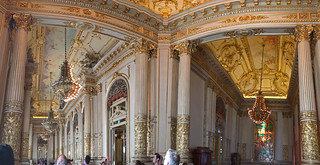

I learned that the Teatro has one of the best acoustics in the world. The tour also led us to the orchestra seats, the President's suite, and the middle suites.

I also loved the interior design. I can't imagine the amout of work to refurbish the huge theatre. The other details such as stairs, hallways, ceilings, floor tilework, sculptures are so impressive as well. The theatre also has an area, sort of like a museum, where the old costumes used in popular productions are on display.

BA is probably the only city where a visit to the city's cemetery was part of my itinerary. One of BA's most famous daughters is resting at the Recolleta Cemetery. I'll let you guess. Clue. "Don't cry for me, Argentina." Evita Peron rests here. Look for her under her maiden name of Duarte.

To find her and the other more popular residents at the cemetery such as former Argentine Presidents, there is a map by the entrance. It was hard to keep a sense of direction when inside a cemetery because it is very dense and there are no street names inside. There were fresh flowers on her mausoleum door.
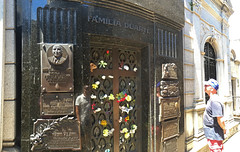
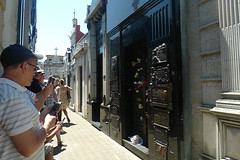
The past glory of BA is even evident in this cemetery.
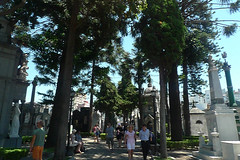
This is not part of the cemetery. I took this photo while crossing 9 de Julio Avenue. An Evita face is on the building facade.
Cafe Tortoni is also on Avenida de Mayo and this is where we saw a tango cabaret show one evening. This cafe is good because it is a one stop shop. You can have a light lunch, or a light snack, or an afternoon coffee with a pastry or watch a tango show.
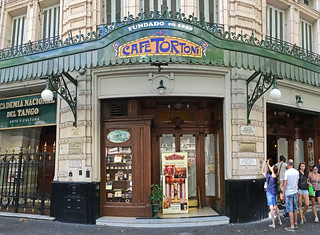
The place could be a bit touristy but if you look beyond that, you'll enjoy the scene and the old world feel.
We saw a couple of live tango dances in BA and most of them we saw in Barrio San Telmo. This is probably one of my favorite places in BA. The streets are cobbled stone, lots of cafes and restaurants and antique stores.

Also in this barrio is Plaza Dorego. This is where we saw lots of tangos. Seeing the tango upclose like this made me appreciate the dance and the music as an art form. I am no connoiseur of dance but I've seen lots of dances and ballets in San Francisco and I can tell the tango dancers are amazing. The steps, the skill, the passion, its dizzying sensuality and the coordination between two people dancing. The music evoke the same emotion and passion.
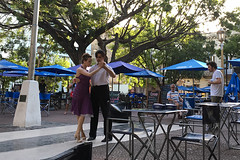
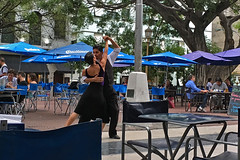
Mijo and I loved it so much here, we walked around the neighborhood twice. One in the morning and one in the afternoon.
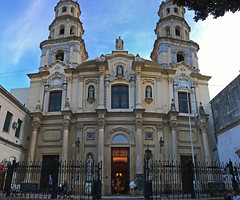

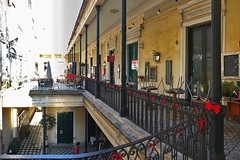
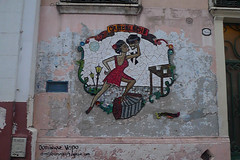
A trip to BA is not complete without a visit to Museo Casa Carlos Gardel. He is probably Tango's most popular singer he was referred as the King of Tango.
I usually notice the Argentineans soccer fans everytime I watch the telecasts of World Cup. How passionate and die hard they are to their team. Mijo and I went to check out the Boca Juniors stadium and I was face to face with this passion.
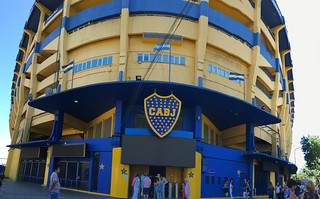
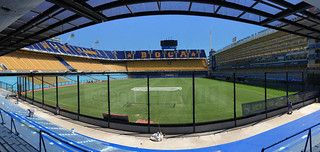
Soccer or futbol is truly popular in Buenos Aires and Argentina. They do eat, breathe and sleep futbol.
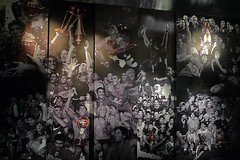

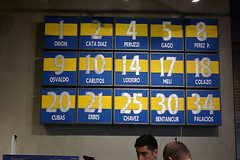
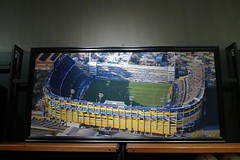
El Caminito is a colorful area in the Barrio La Boca. This area was the inspiration for the famous tango "Caminito" composed by Juan de Dios Filiberto.
Speaking of arts and artists, I am impressed with BA's Museo Nacional Bellas Artes. It has a well rounded collection and my favorites like Monet, Van Gogh, Picasso and Rivera are represented in the museum.
More on the arts. I found these murals at the Galleria Pacifico mall worthy of a place at a museum. The murals are in dome in the middle of the mall. So cool to have a mall like this one.
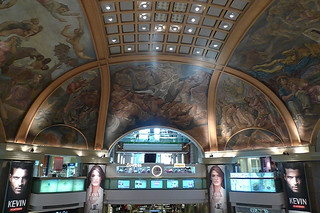
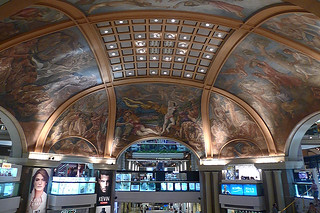
I also found a local mall that sells cute polo shirts called La Martina. Another local brand called Satori also has cute outfits and shoes for men.
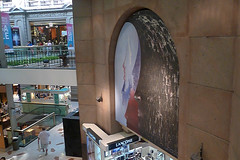
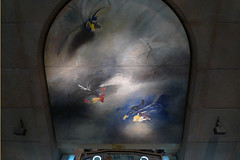
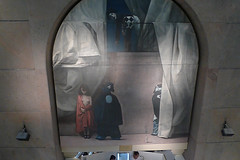
At the end of San Telmo, we chance upon the Museo Arte Moderno. This was not in my itinerary but it was a great addition to our site seeing.
Mijo and I took BA's extensive Subte to get around the city.
Here are more BA scenes.
This church is on Avenida Belgrano called the Convento Santo Domingo.
This church is on Avenida Belgrano called the Convento Santo Domingo.
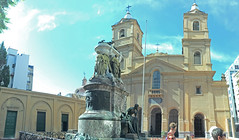
Here is a quirky sculpture also on Avenida Belgrano.
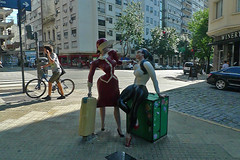
We saw this giant sculpture called Floralis Generica near the Museo Nacional Bellas Artes.
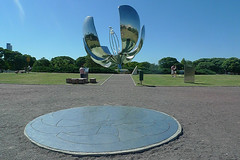
This tree near the Teatro is huge.
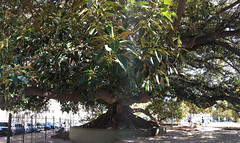
Here's a view of the newer part of BA called Puerto Madero where skyscrapers abound. This view is from the rooftop of our hotel in BA called Moreno Hotel.
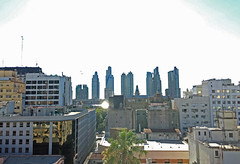
A La Boca mural.
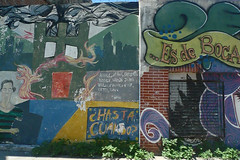
The airport is locally known as Ezeiza. We got to the airport a little early and we had time to check out the public spaces and arts.
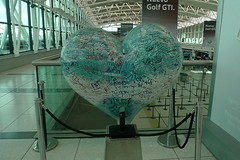

In terms of food, here are the different food we tried in BA.
Sweet breads are called facturas. We had these at Nueva Embajada on Avenida de Mayo.
Sweet breads are called facturas. We had these at Nueva Embajada on Avenida de Mayo.
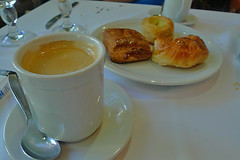
These delicious churros were paired with a cup of hot chocolate at Cafe Tortoni.

We had a great lunch at Cumaná near Recoleta. We've had traditional Argentinean food like a carbonara which is a pork stew with veggies, empanada, and locro is also a stew with beans and meat.
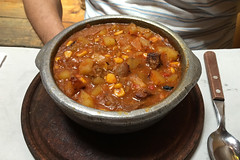
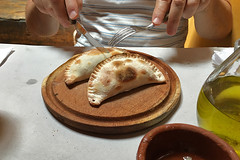
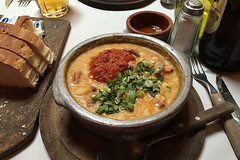
Another great lunch was at Ribera Sur in the Barrio La Boca. We tried the chorizo which is a grilled thick cut steak, the napolitano which is a battered meat.
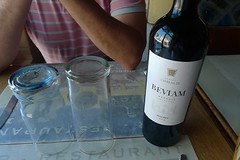

At La Vieja Roteseria in Barrio San Telmo, we had an amazing dinner of beef tongue and chorizo (steak).
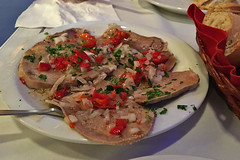
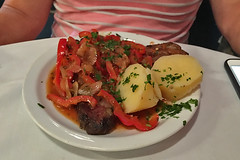
Empanada snack at Mi Tio, also in San Telmo.
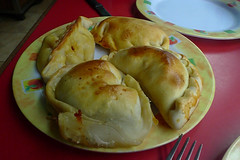
Another empanada snack at Gran Pizzeria also in San Telmo.
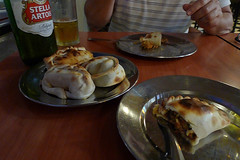
Here's what our breakfast looked like at Moreno Hotel.

Muchas gracias, Buenos Aires!
~rl


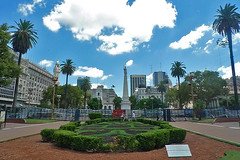
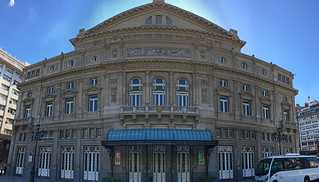






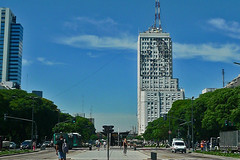
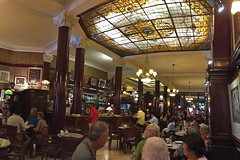
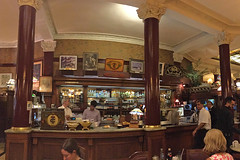
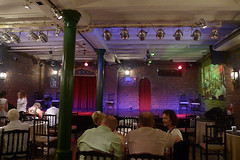



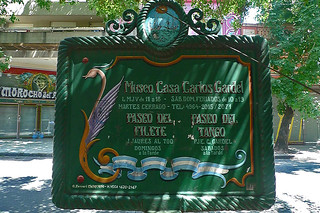




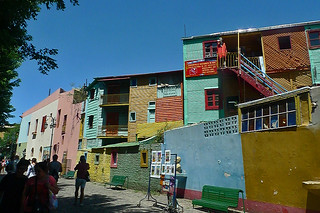
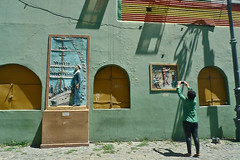
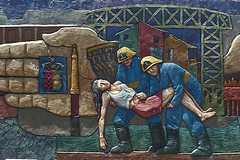

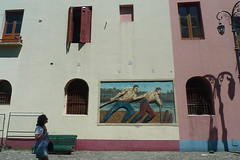
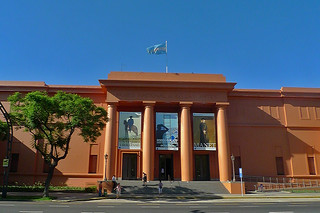
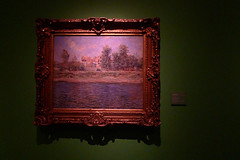
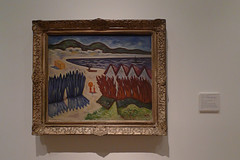
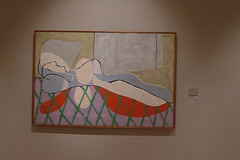

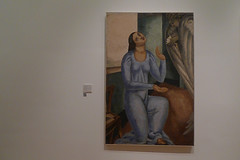
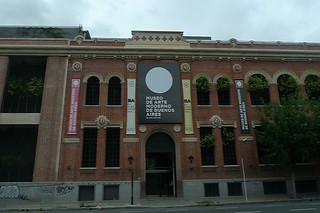
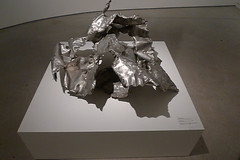


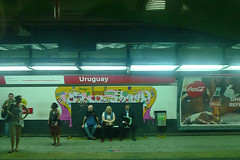
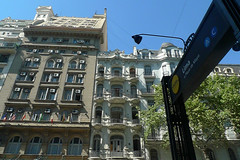
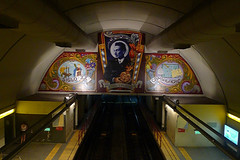

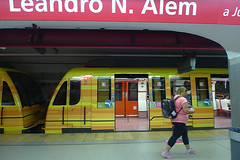
No comments:
Post a Comment